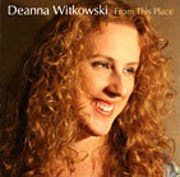I have two suggestions: first, my From This Place songbook. This book contains lead sheets, fully notated piano parts, choral scores, and bulletin inserts that correspond to 14 of the 15 pieces on my sacred jazz recording of the same name. All of the piano parts also have chord symbols- so it's a great way for keyboardists who are stymied by a G7(#11) to see the symbol and a written out voicing of that chord in the piano score. Click here to download a sample from the songbook.
Second, have my trio come and give a workshop at your church! We are available to work with just singers, or with singers and instrumentalists, or with music directors and pastors. Here is a description from a recent workshop:
How does one integrate jazz in worship in an unforced, organic way that involves the entire congregation? Do you have to know how to improvise in order to lead your community in a jazz arrangement of a well-known hymn? Does the congregation have to have printed sheet music? How do you tell the drummer what kind of feel to play (or, if you are a solo pianist, how do you lead without a drummer)? New York-based jazz pianist/composer/vocalist Deanna Witkowski is a former Episcopal church music director who actively composes sacred jazz for corporate worship. With her trio (acoustic bass and drums), Witkowski will lead participants in singing original hymn arrangements, psalm settings and service music with and without sheet music. Keyboardists will be provided with fully notated piano parts in addition to lead sheets (chords and melody) to use in their respective congregations. A resource handout with links to additional sheet music resources and sacred jazz composers will also be provided. Witkowski's sacred jazz recording, "From This Place," along with her corresponding sacred jazz songbook (14 sacred jazz pieces: congregational, choral, and solo, with fully notated piano parts, lead sheets, and bulletin inserts) will also be available for purchase.
Stay tuned for more suggestions of how to creatively integrate jazz into the musical repertoire of your congregation...and let me hear your suggestions as well!



